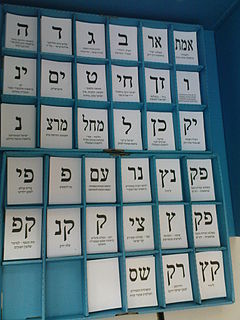
Ratz, officially the Movement for Civil Rights and Peace was a left-wing political party in Israel that focused on human rights, civil rights, and women's rights. It was active from 1973 until its formal merger into Meretz in 1997.
The Democratic Movement for Change, commonly known by its Hebrew acronym Dash was a short-lived and initially highly successful centrist political party in Israel. Formed in 1976 by numerous well-known non-politicians, following a spectacular breakup, it had ceased to exist within less than two years.
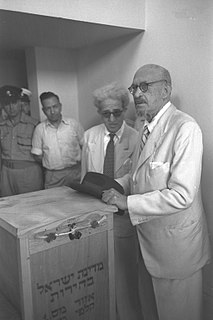
Elections for the second Knesset were held in Israel on 30 July 1951. Voter turnout was 75.1%.
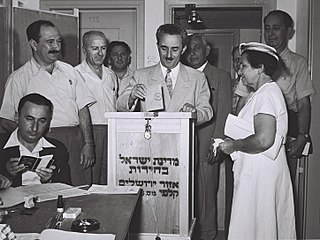
Elections for the third Knesset were held in Israel on 26 July 1955. Voter turnout was 82.8%.
Poalei Agudat Yisrael was a trade union and Jewish political party in Poland, and was a minor political party in Israel. It was also known as PAI or PAGI, its Hebrew acronym.
Elections for the fifth Knesset were held in Israel on 15 August 1961. Voter turnout was 81.6%.
Elections for the sixth Knesset were held in Israel on 2 November 1965. Voter turnout was 85.9%.
Elections for the seventh Knesset were held in Israel on 28 October 1969. Voter turnout was 81.7%.
Legislative elections were held in Israel on 17 May 1977 to elect the ninth Knesset. For the first time in Israeli political history, the right-wing, led by Likud, won a plurality of seats, ending almost 30 years of rule by the left-wing Alignment and its predecessor, Mapai. The dramatic shift in Israeli politics caused by the outcome led to it becoming known as "the revolution", a phrase coined by TV anchor Haim Yavin when he announced the election results live on television with the words "Ladies and gentlemen—a revolution!". The election saw the beginning of a period lasting almost two decades where the left- and right-wing blocs held roughly equal numbers of seats in the Knesset.

The Alignment is the name of two political alliances in Israel. Each of these Alignment parties later merged into what is now the Israeli Labor Party.
Elections for the eleventh Knesset were held in Israel on 23 July 1984. Voter turnout was 78.8%. The results saw the Alignment return to being the largest party in the Knesset, a status it had lost in 1977. However, the party could not form a government with any of the smaller parties, resulting in a national unity government with Likud, with both party leaders, Shimon Peres and Yitzhak Shamir, holding the post of Prime Minister for two years each.
Elections for the 12th Knesset were held in Israel on 1 November 1988. Voter turnout was 79.7%.
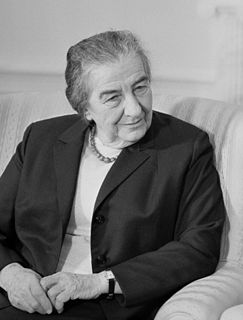
The fifteenth government of Israel was formed by Golda Meir on 15 December 1969 following the October elections. The government was a continuation of the national unity government formed during the previous Knesset, and consisted of the Alignment, Gahal, the National Religious Party, the Independent Liberals and the Israeli Arab parties Progress and Development and Cooperation and Brotherhood. Gahal left the coalition in early August 1970 after the government agreed to accept the Rogers Plan.

The thirteenth government of Israel was formed by Levi Eshkol on 12 January 1966, following the November 1965 elections. His coalition included the Alignment, the National Religious Party, Mapam, the Independent Liberals, Poalei Agudat Yisrael, Progress and Development and Cooperation and Brotherhood, and had eighteen ministers.

The fourteenth government of Israel was formed by Golda Meir on 17 March 1969, following the death of Prime Minister Levi Eshkol on 26 February. She kept the same national unity government coalition, including the newly formed Alignment alliance of the Labor Party and Mapam, as well as Gahal, the National Religious Party, the Independent Liberals, Poalei Agudat Yisrael, Progress and Development, Cooperation and Brotherhood. The only change to the cabinet was the scrapping of the Minister of Information post, with the previous post-holder Yisrael Galili becoming a Minister without Portfolio instead.
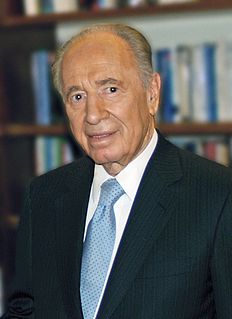
The twenty-first government of Israel was formed by Shimon Peres of the Alignment on 13 September 1984, following the July elections. With both the Alignment and Likud winning over 40 seats each, neither side could form a stand-alone coalition, resulting in a national unity government, together with the National Religious Party, Agudat Yisrael, Shas, Morasha, Shinui and Ometz, which together held 97 of the 120 seats in the Knesset. However, in protest at the alliance with Likud, Mapam broke away from the Alignment, as did Yossi Sarid, who joined Ratz.
